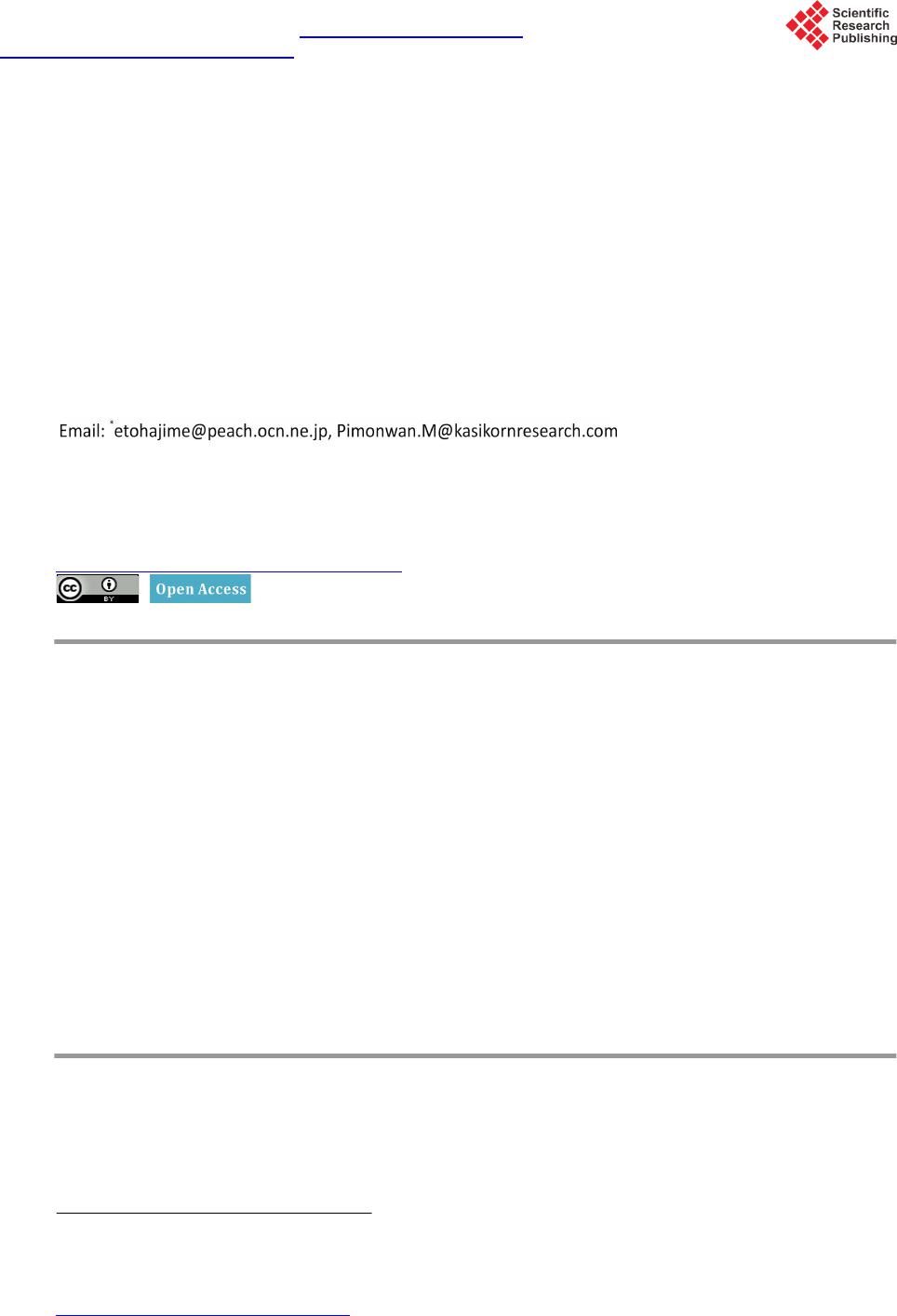 Open Journal of Social Sciences, 2015, 3, 215-224 Published Online November 2015 in SciRes. http://www.scirp.org/journal/jss http://dx.doi.org/10.4236/jss.2015.311026 How to cite this paper: Eto, H. and Mahujchariyawong, P. (2015) Feasibility and Acceptability of Long-Staying Healthcare Service Facilities in Developing Areas. Open Journal of Social Sciences, 3, 215-224. http://dx.doi.org/10.4236/jss.2015.311026 Feasibility and Acceptability of Long-Staying Healthcare Service Facilities in Developing Areas Hajime Eto1*, Pimonwan Mahujchariyawong2 1University of Tsukuba, Tsukuba, Japan 2Kasikorn Research Center, Bangkok, Thailand Received 15 October 2015; accepted 16 November 2015; published 19 No vemb er 2015 Copyright © 2015 by authors and Scientific Research Publishing Inc. This work is licensed under the Creative Commons Attribution International License (CC BY). http://creativecommons.org/licenses/by/4.0/ Abstract This paper proposes to construct long-staying healthcare service facilities in developing areas for the purposes to serve the local people and the visiting people from the distant areas including de- veloped areas or foreign countries. This is a new business model of half-public and half-private character to complement the insufficiencies of and to fill the gaps between the governmental me- dical aid from developed countries to developing countries and the medical tourism from devel- oped areas to developing areas or vers e versa mainly at individual levels. Using a set of conceptual methods like need analysis, obstacle analysis, conflict analysis and complementarity analysis, this paper examines the merits and the problems of the proposed third type (eclectic) system to health- care service providers, service users, the host areas and the local communities. Keywords Elderlies, Healthcare Service, H ospice, Hospital ity, International Medical Aid, Medical Tourism, Need Analysis, New Business Model, Nursing Home, Obstacle Analysis, Wearable Medical Apparatus 1. Introduction 1.1. Problem Statement It is difficult to deliver healthcare service to everybody and everywhere [1] [2]. In particular, the delivery of *Corresponding author.  H. Eto, P. Mahujchariyawong healthcare to foreigners and elderlies meets obstacles [3]-[5]. International medical aid mainly by government and medical tourism mainly by business have contributed to the dissemination of healthcare r esources to devel- oping areas and to the fosterage of healthcare professionals in such areas. This paper extends these ideas to the const ructions of long -staying healthcare service facilities like sanatoriums, nursi ng home s, rehabilita tion centers, hospices, and the likes in developing areas. Then this paper assesses the feasibility or marketability mainly on the sides of healthcare service providers, and the acceptability mainly to service users and host areas. Hereafter, “healthcare” is sometimes abbreviated as “care” when the medical factor is weak. 1.2. Aim and Scope of This Paper The aim of this paper is to propose and assess the idea to construct long-staying healthcare service facilities in developing areas both for local patients and elderlies (users hereafter) as in medical aid and for visiting users from other areas including foreign countries as in medical tourism. For this aim, this paper briefly reviews both problems of medical aids and medical tourism to learn lessons. Then this paper analyzes the needs and their sa- tisfactions on both sides of healthcare service providers and users, the soc ial and econo mic feasibility includ ing the business opportunity and marketability, and the socio-cultural conflict with and acceptability to the local communitie s in host areas by complementing t he benefits of e ach other. 1.3. Method This paper uses a set of conceptual analysis methods rather than mathematical, statistical or interview methods. Learning the lessons from nationwide or international sanatoriums for chronic diseased patients and internation- al medical aid p ro gra ms b y go vern ment, this paper applies the methods of need analysis, obstacle analysis, con- flict analysis and complementarity analysis [6]-[9] to the idea of international healthcare service facilities. 1.4. Planning and Managing Process and the Definitions of Terms The terms use d in thi s pap er are defined not in a ve rbal way but as the ro les to play in t he pla nning a nd mana g- ing pro cesses . Step 1. The healthcare-service provider (donor in governmental medical aid, and sponsor, promoter or in- vestor in medical tourism business) examines the need of healthcare-service users (patients, elder lies, etc.) and promotes the construction of a healthcare-service facilit y (ho spita l, sanatoriu m, nur sin g ho me, hospice, etc.) in a developing area (host area) for visiting long-stay users of local reside n ts and for users from distant areas (in- cluding foreign countries) . Step 2. The community (local governments, resident’s associations, etc.) of the host area accepts it. Step 3. T he healthcare-service users or patie n ts (diseased, handicapped, elderly people, etc.) co me fr o m e ve- rywhere (abroad or host area) to receive the healthcare services. Step 4. The healthcare-service users (simply care-service users or users) can stay in or outside the facility (in-user or out-us er like in-patient or out-patient in hospita l) [10]. Step 5. The healthcare-service users (particularly from distant areas) can possibly enjoy the communication (e.g., recreational ac tivities) with the community in the hos t area. Step 6. The care-service users receive various services possib ly includi n g reli gious ser vice s fro m the facilitie s or the community. Step 7. The care-service users can stay there long possibly to the end: terminal care [11]. Step 8. Users staying outside the facility can use wearable medical apparatus. The obtained information can be sent to the facility and, upon request, to the family at the home (remote monitoring system). Medical service, healthcare service, care service and welfare service are not synonymous but often indistin- guishable and overlapping. Hereafter these words are used as nearly synonyms with slight diffe rences in nuance. 1.5. Structure of This Paper Section 2 reviews the present problems around healthcare services. Section 3 reviews the problems of retirees and other expected care-service users. Section 4 discusses the cultural and other gaps between areas or countries. Section 5 examines the feasibility, marketability and acceptability of the proposed facilities to both sides. Sec- tion 6 revie ws sever a l sites for the p ossible constr uctio ns. Sectio n 7 state s the conclusion.  H. Eto, P. Mahujchariyawong 2. Problems of the Healthcare for Care-Service Users 2.1. Obstacles and Difficulties The international medical aid by governments is a humanitarian aid to developing countries for the benefit of the local people without regard to the economic benefit of the donors. Without economic incentive, the donors are often reluctant to international medical (and other) aid. Or, the donors may not be sufficiently careful about the host areas and the local people there by implicitly taking the own benefits into consideration. This is seen for Japan as the leading donor in Southeast Asia. In the recent decades, indeed, larger parts of Japanese aid are in the form o f l oan ai d than gr ant a i d [12]. These problems tend to o bstruct the successes in i nternational aids. At private or individual le vels, meanwhile, healthcare-service users (mainly the diseased) visit medical facili- ties with mod ern equip ment ( often in big cities) distant from home or even from abroad for the purpose of hos- pitalization, surgical operation and other modern treatments. Meanwhile, some of care-service users in devel- oped countries avoid the expensive facilities in developed ar eas (or countries) and choose the facilities in devel- oping areas (or countries) for the reasons of cost and cultural (often language or religious) familiarities. Many patients of tuberculosis in cities are hospitalized in sanatorium in clean air areas. These are called the medical tourism [13]. Medical tourists (healthcare-service users) stay in the destinations (mainly hospitals or sanatori ums) for several weeks, months or years. When the destination areas are the homelands of healthcare service users, they want to stay there to the end of the life (terminal care). Even if not the homeland, some areas may be the spiritual (the mot her languages or r eligious) homeland s of users [14] [15]. Then the y may want to have the te r- minal care there. Otherwise, the healthcare-service users often feel alienated. A classic form of long-staying medical tourism is seen in sanatoriums mainly for chronic-diseased patients like tuberculosis or Hansen’s disease (lepra , leprocy) patients, who suffered for many years possibly until the end of life. The Empress Komyo and later a Buddhism priest Ninsho constructed long-staying hospitals for Hansen’s diseased and other chronic diseased patients in the 700 s and the 1200 s, respectively. In an interna- tional aspect, a German doctor Er win von Baelz believed the medical efficacy of hotspring water and planned to construct a long-staying hospital for Hansen diseased patients in Kusatsu Spa, Japan, in the late 1800 s by bringing the patients from Europe to Japan via Siberia or the Indian Ocean, although the Japanese government and the local residents finally rejected his plan. Another classic form of medical tourism is to own second houses in healthy places (clean air, etc.) and stay there for the vacation or after the r etire ment at a n individua l level. I ts varia nt is to sta y lon g in hotels for tr eatin g the diseases in healthy place or hot-spring areas [16]. Sanatoriums or second houses are usually located in countryside or resort areas, and the user s stay there se v- eral months or often years for spending peaceful lives possibly rather than medical treatment. Care houses, nursing homes, hospices accept and care the users usually for years possibly to the end of life as the terminal care [17]. As their co mmunic ations with the communities of the host areas or the religiou s services to them are often poor, long-staying users tend to feel alienated from the society or loose their spiritual lives and tend to loose the morale to live long. This obstructs the longevity in medical touris m. The health insurance is a problem for international medical tourism. The system varies from one country to another. T his promotes or ob structs internatio nal medical to urism [18]. T he visa s yste m is a nother problem. The long-stay visa system is needed for medical or healthcare tourism. Thailand and Malaysia issue the long-stay (10 years) visas. 2.2. Healthcare Wor kf orce The healthcare professionals are scarce in many countries. In medical tourism, India is in a favorite condition because of the big population of English speaking medical staff [19]. Malaysia is also in a favorite condition [20] not only because of the English speaking population but also the cultural similarity with the oil-rich Arabic countries [21]. In many countries, the healthcare sectors suffer from the workforce shortage, although healthcare workforce is critically i mpor tant for the healt hcar e qualit y [22] [23]. Japan offers a nurse-tra ini n g p ro gr a m a nd c al ls fo r t he trainees from Southeast Asia, pa r ticular ly, from Indonesi a, to train them in Japan. The obstacles are the language gap and the food difference between Japan and Indonesia. For example, the Ind onesia ns like sp icy fo od and do not eat pork (halal or haram). One solution is that the care-service users (patients, elderl ies, etc.) go and stay  H. Eto, P. Mahujchariyawong abroad. The problems of staying abroad are the gaps in language, customs, food, culture, climate, and others. When a providing country constructs healthcare-service facilities abroad, the local workforces in the host areas are employed as the staff there. In this situation, the language and other cultural gaps take another form: the language and cultural gaps between the local staff and the healthcare-service users from abroad. As these prob- lems are directly related to the quality of healthcare service [24], some training programs may be needed for both sides. 2.3. International Assistance in the Aged Society Internatio nal cooper ation is importa nt in the world [25]. This is executed b y various institutes (e .g., JICA: Japan Internatio nal Coop eratio n Agenc y). Until 20 13 , T hailand had received JICA technical assistance on 156 projects and 216 development studies worth THB67.4 billion (JPY222.498 billion), a s well as THB52 billion (JPY170.235 billion) in grant aid. Meanwhile, Thailand received ODA loans for 242 projects that totaled THB656 billion (JPY2198.621 billion) including large projects such as the mass-transit system in Bangkok and Suvarnabhumi Airport (Ministry of Foreign Affairs of Japan, 2013). Here, ODA denotes Official Development Assistance by government. Since Thailand has joined the ranks of upper-middle inco me countries, the recent aids from Japan to Thailand are mainly in the form of assistance for sustainable social and economic development. The issues being ad- dressed by JICA’s assistances include the enhancement of industry competitiveness, the measures for the aging population and socially vulnerable people, as well as environmental problems and climate change. One of the focused issues of JICA’s supports to Thailand is the cooperation to improve social services and healthcare con- cerning senior c itiz e ns [26]. According to Thailand’s National Economic and Social Development Board, Thailand has already become an aging society (7 - 14 percent of the entire population is age 65 or older), and is expected to enter an aged society (14 - 21 percent is age 65 or older) by 2024. An example of JICA’s Cooperation on Aging Society is “Project for the Long-term Care Service Development for the Frail Elderly and Other Vulnerable People”, which pro- vided model service, and training programs of the care workers and coordinators. In addition, because public care facilities for the aged are scarce with only 2 places in Bangkok, Japanese Chamber of Commerce in 2005 donated for expansion o f the facilities at B an Bang Khae Social Welfare Develop ment Center for Older Persons in Ba ngkok [27] [28]. 2.4. Native and Spiritual Homelands Many people feel easy, relaxed, peaceful and relieved in their native homelands. Outside the homelands, simi- larly, many peo ple want to have their spiritual homelands, where they feel peaceful and relieved [17] [29] [30]- [33]. For example, many Japanese people feel relieved in Chiang Mai, an old capital in the northern part of Thailand, where old Buddhism temples are standing although Thai Buddhism is very different from Chinese, Korean and Japanese Buddhism. But, unlike the Catholic system, the B uddhist s usuall y do no t mind t he differ- ence between the s ect s withi n the Buddhism. There are different sects in Buddhism, basically in south (India, Sri Lanka, Myanmar, Thailand, Laos, Cam- bodia, etc.), north (China, Vietnam, Korea, Japan) and Tibet-Bhutan-Mongol (often mistakenly called the La- maism). But they have been very tolerant of each other. Unlike the Catholic (katolikos in Gr eek fro m kata + ho- los = who le, universe), ther e ha s bee n no ce ntr aliz ed s yste m t o uni fy the B uddhi sm. T his is no t un usua l. Rat her , the un i ver sa l Ca tho l ic C hur c h s ystem i s e xc ep t io nal e ve n wi thi n t he Chr i sti a nit y. I n the G re ek O r t hod o x C h urc h (Eastern Orthodoxy), the Russian Orthodoxy, the Ale xandrian, the Jerusalem, and others are quite autonomous. Armenian, E thiop ia n, Persian and Chinese (Jing-Jiao from Nestorius) Christianity are also different eac h other. Therefore, the religious difference is not serious for many people except for believers of some religions. 2.5. Hospitality One of the most decisive factors for the success is the hospitality of the healthcare service providers and the friendship of the local communities in the host areas. In the international healthcare services, these t wo factors are partly determined by the friendship between the host areas and the home countries of healthcare service us- ers. The cultural similarities between them are desirable. This must be considered before the construction of the  H. Eto, P. Mahujchariyawong facilities. 3. Postretirement Life 3.1. Retirement In many Japanese companies, people usually retire at age 55. Some people find new jobs but retire again after several years’ works there. Many retirees move to countryside (e.g., ho meland) for the reasons of healthy envi- ronment (clean air, etc.), cheaper living cost, tastes (fishing, painting, etc.) and others. Some other retirees live outside home countries to renew the lives [34]. Indeed, many Japanese retirees live in Southeast Asia to enjoy marine sp or ts. 3.2. Postretirement A ctivities Retirees enjoy the postretirement life according to their taste or hobbies [35]. A popular site for long-staying Japanese retirees is Chiang Mai, Thailand. They voluntarily organize the Japanese Association there for their friendship. Accor ding to the Association, more than 3,000 Japanese (mainly retirees and the wives) live long in Chiang Mai with long-stay (10 years) visa. In addition, more Japanese without long-stay visa also live there. These Japanese like Chiang Mai for its merits of comfortable climate, historical legacy, landscape, people’s friendliness, and world-famous healthy Thai food (vegetables, fruits, fish, chicken rather than beef with mod- erately salty taste by using the condiments of fish sauce called nam pla for flavor). Some elderlies like the Thai classic massage (nuat phaen boran), which is d eeply related to the Buddhism and Indian Ayurveda therapies. 4. Cultural and Social Differences 4.1. Cultural Tolerance Tha i cult ure i s qui te t ole rant o f o ther cult ur es. T hai land i s a Bud dhis m co untr y, a nd ma ny Tha i pe opl e re gularl y worship at the Bud dhism te mple s. But they are tolerant of peo ple of other religions or no religion. The problem may be on the side of the healthcare-service users from abroad. Some users persist with their re- ligions. They may demand their religious services on particular days (Sunday, Friday, Easter Day, Christmas Day, etc.) in particular styles (e.g., with hymns). It is difficult to satisfy such cultural or religious demands. As Buddhists usually do not stick to particular services of religion, they refrain from such demands and will cause few troubles. 4.2. Language and Food Gaps The differe nces in t he langua ge and food ser iously ob struct the frie ndly co mmunicat ion. B elieving t hat English is “THE” universal language and that everybody should speak English, En glish-speaking users might be fru- strated with and might scold non-English speaking staff of the facilities. The Japanese and some other users may endur e t he l a n gua ge ga p s b ut, at the sa me time, ma y b e ve r y frus t ra te d wit h t he p o ve rt y i n the l a ng ua ge commu- nication. As few Japanese speak or read Thai language or characters, they may have some trouble in mixing with the local communities. Generally, Japanese do not speak foreign languages well because, a s man y lingui sts and br ain scienti sts say, Japanese language is very different from the other languages. Instead, Japanese are ac- customed to the language gap and can endure it. The commu nica tio n is not o nl y thr oug h la ngua ges. T o do somet hing to ge ther (r ecr eati on, public ser vice, etc.) or the collaboration of the foreign users with the local community are good ways for the communication. It may be requested to design such programs. As some people implicitly or sometimes explicitly have the ranks in language (classically French and now English is the BEST language superior to the others), some people implicitly or sometimes explicitly have the ranks in food (classically French and now American food is superior to the others). Many Japanese people used to have the rank in food: Spicy food (e.g., in South and Southeast Asian and Korean) and salty food (e.g., in t he northeast part of Japan) are infer ior while the natur al or lig ht taste (typically Kyoto food) is elegant and graceful. But this rank is now reversed in Japan. Today many Japanese like or even prefer spicy food [36] and even s alty food by ignoring the medical advices. The food gap between Southeast Asia and Japan is narrowing.  H. Eto, P. Mahujchariyawong 5. Need Analysis 5.1. Demand and Feasibility Social or economic demands for healthcare facilities of long-stay type are strong in many countries. No w there are many aged people in many countries as compared to the r elatively small numbers of young generations be- cause of the baby boomers born in the postwar period (1946-1949). This imbalance between the aged and young generations causes the serious shortage of workforces in the healthcare sector. This situation demands the con- struction of healthcare facilities abroad with less generation imbalance. In some countries including Japan, the aged people are relatively rich because of their economic stock saved during the economic prosperity around the 1980s. Therefore, it is financially feasible for such aged people to go abroad for the long-stay in the healthcare service facilities abroad, particularly in developing areas with the availability of well-trained healthcare service workforce [24]. The use of the remote monitoring or diagnosis system mitigates the heavy burden of workforce, and the telecommunication from the system to home eases the anxieties of the families living in distant areas. This raises the demand. If many retirees already live in some developing areas, t hey are surely expected to welcome the construction of suc h welfare facilities in these areas by their homecountry’s government or business, b ecause it mitigates the langua ge a nd othe r cul tural tr oub les. T he cons truct ion o f facil ities i s relat ivel y inexp ensi ve in d evelop ing ar eas. Some developing areas have already the well-developed education system and potentially have the candidates of healthcare workforce. This solves the most difficult obstacle of the availability of healthcare workforce in de- veloped areas. The complementarity in population structure between developed (highly aged) and developing (less aged) areas leads to the mutual help. Experiencing healthcare facilities, developing areas learn useful les- sons for their future aged society with the experienced healthcare workforce. In this way, t he co nstr uctio n of t he facility contributes to the resolution of conflict between developed and developing areas by utilizing the com- plementarities between the m and is beneficial to both sides. If the first setup meets some social obstacle to winning the local acceptance, gover nme nt ( the E mba ssy o r the related agencies) of the healthcare-servic e p ro vider ar eas ca n he lp the co nstr ucti on pl an b y ta lki ng to the ce ntral or local governments of the host area Such a governmental interference in the construction of facilities by pri- vate sectors is often seen and socially acceptable in the construction of education, healthcare or research facili- ties even by private sectors. This is helpful in overcoming the obstacle. As many retirees are still healthy, the y are not “hospitalized” but live outside the facility like o utpatients. For safety, they may carry wearable medical apparatus with them for remote monitoring. Such information can be sent to home doctors in the homeland by electronic systems. This improves the safety and raises the demand without incurring heavy cost [37]. 5.2. Volunteer Activities with the Communities in the Host Areas Except for diseased or highly aged people, the healthcare service users may be desired to join the recreational and other volunteer activities with the communities in the host areas [38]. This promotes the communications between the healthcare service users from distant areas and the local communities in the host areas [34]. In Thailand, there are a number of organizations that support Japanese long-stayers’ activities. The Japan- based organizations include Long-Stay Foundation (Japan), which Thailand-Japan Long-Stay Promotion Asso- ciation and, locally, Bangkok Salon. These two agencies have entities that provide information, advices, and cooperation related to the Japanese long-stay in Thailand. In Chiang Mai, apart from the Consulate-General of Japan in Chiang Mai and the Chiang Mai Japanese Association where Japanese can acquire information con- cerning long-stay at e it he r t he c ount r y- or provincial-level, there are several long-stay organization s as well. T he large st gro up is the C hian g Ma i Long-sta y Life Club (CLL Club). They works as the center to contact with Thai gover nment agenc ies a nd loc al entities to arrange acti vities such as volu nteers, Thai-Japan festival, s emina rs o n long-stay, sports or recreation activities (such as spa, golf, and traditio nal culture), as well as coor dination with consular in giving advice to members. 5.3. Acceptability People of some culture and other people of other culture (e.g., r eligion) are sometimes reluctant to live together as the history shows. But the Buddhism people tend to accept different cult ure. An India n saint said that many  H. Eto, P. Mahujchariyawong people talk different words with the same meaning. According to this Indian idea, seemingly different cultures can peacefully coexist and accept each other. In this respect, the Buddhism countries are appropriate to have in- ternational healthcare facilities. In fact, T hailand and J apan have already launched the cooperation programs for the aged societies. Thai people in Chiang Mai relatively have the positive attitude toward Japanese due to their nature of polite- ness. Japanese spending there also creates jobs and transfers wealth to the host areas. Thai government aims at promoting high-valued services to generate income and create jobs in the country. The long-stay program is one of the target progr ams benefiting the tourism, healthcare ser vice and real estate sectors [39]. The use of the remote monitoring or diagnosis system is welcome in the host areas because it stimulates and promotes the development of medical electronics technology in these areas. 5.4. Return to Spiritual Homeland for Terminal In ma ny cult ures, the end of life is important [11] [40]. In some countries like China and Japan, it has tradition- ally been extremely important to collect many people to the funeral service for the purpose to demonstrate the power of the family. In the family centric s ystem in the feu dalism era, t he fa mily wa s somet hing l ike t he pol iti- cal party, the business or the company. In many social, po liti cal or eco nomic systems, the scale or the size of the nation, business and political party is important. When family was an extremely important unit in society, the scale of funeral service represented the power of the family. Similarly, having a large attendance at the funeral service is i mportant to the family. T his pro motes retirees to have the postre tirement life in homela nd or spiritual homeland surrounded by the family and/ or inti mate fri end s . In many cultures, the corpse is buried in earth (inhumation or interment burial) beside the water burial, tree burial, platform burial, corps exposure, and others in other cultures. For the sanitariness purpose, the corpse is burne d (c r e mation) i n so me c ul t ure ( t ypic ally i n the B ud d hi s m). The c r e mat io n s yste m c a me wi t h t he B ud d hi s m fro m I nd i a to J a p a n i n t he 70 0 s. At f irst, J apa nese peop le reg arded it cr uel to bur n out the corpse. Shoku-Nihon-gi, the third oldest history book authorized by the Emperor in the end of 700 s describes its social impact. Gradually, however, the inhumation or interment system was replaced with the cremation system for the sanitariness pur- pose. Today, the inhumation is not practiced in Japan. Japanese patients and the families prefer the cremation system and wish to perfor m the funeral service in the cremation system. As the cremation system is general in many Buddhism countries, t he fune ral system in the Buddhism countries is acceptable to the users and the fami- lies from the Budd hism countrie s, but may not be acceptable to non-Buddhists who feel the cremation as cruel. After the cre mation, t he ash i s i mportant in the Budd hism. In fact, the ashes (sarira in Ind ia o r shari in Ja pa- nese) of Buddha were delivered to several Buddhism temples and some came to Japan, where Horyu-ji temple outside Nara City and a few other temples still keep them. In J ap anese words, “to bury the bones (or ashes) apart from homeland” means the tragic or lonely death apart from home. Another Japanese word “nozarashi” literally means “wind in the field” or “the corps unburied or abandoned in the field”, but usually means “the death apart from homeland”. Still today, J apanese government and some volunteer groups visit China, Southeast Asia and Oceania (New Guinea, Maria na, etc.) to collect the abandoned bones of the dead soldiers, to cremate the bones to as hes and to br ing b a ck t he a she s t o t he fa mi l ie s. I n s uc h c ult ur e , the family of Japanese diseased in the facili- ties may earnestl y want to bring the as hes to the home co untries to bury in the fa mily tomb . For this, it is neces- sary that the family brin gs the ash into the cabin of tran sport ( airplane) or sends it b y “mail package”. The prob- lem is whether this is legally or morally allowable in internat ional contexts or not. The funeral services were extremely important and remain important still today. In the funeral services, the Buddhism “priests” are invited to cite or chant one of the Buddhism scriptures. The Christianity has only one Bible, and the only selection is which part of the Bible to cite. The Buddhism allows the multiplicity of the “Bibles” or the scriptures. It depends on the sect which scriptures to choose. Most of Japanese people do not mind which sect manages the own funeral service or which scripture to be chanted in the funeral services. In other words, any manner of funeral service is acceptable to most of Buddhists. But the situation may be com- pletely differe nt as for other re ligio n be lievers. Islamic and some Christian people may feel the cremation is cruel. Some people may reject the Buddhism pri ests a nd t he c hant of Bud d his m scr ipt ures. For suc h cas es, hospices are co nstructed only in places where par- ticular types of religious services are available, meanwhile many Buddhists accept the local system of funerals. In this respect, the healthcare facilities in the Buddhism countries are acceptable to many Buddhism people.  H. Eto, P. Mahujchariyawong 6. Possible Locations 6.1. Chiang Mai, Thailand Chia ng Mai , 697 km north of Bangkok, has already attracts many Japanese retirees. Chiang Mai is at the heart of nort hern he rita ge, ha vi n g a nc i ent se ve n hu nd re d year s his to r y as a ca p ita l c it y i n t he No r th . It is r ic h i n bo t h na t- ural and cultural treasures, having very distinctive culture, tr a d itio ns, a r ts, festivals, ethnic communities, along with beautiful mountains and waterfalls. Chiang Mai is the second largest province of Thailand in area (after Nakhon Ratchasima), while ranked fifth in population (after Bangkok, Nak hon Ra tcha si ma, U bo n Rat chat hani, and Khon Kaen). Mean while, it is r a nked fifteenth in gross provincial product, amounting to THB184,132 million in 2013. Nonetheless, its per cap ita in- come of THB106,707 remains lower than the country average (THB193,394), which are calculated from Na- tional Economic and Social Development Board’s data. Chiang Mai i s suitable to the long-stay of retirees, particularl y Japanese retirees. In fact, many Japanese reti- rees already live there. Among them, over 3,000 are the long-stayers (10 years visa holders, awarded only to wealthy people with a certain amount of fixed time deposits with Thai banks). Among the entire city population (1,683,020 as of July, 2015), Japanese long-stayers account for about the 0.2%. Including the Japanese short- stayers (1000 - 2000), the Japanese population probably accounts for the 0.3% of the entire population of Chiang Mai City. The climate is comfortable to many Japanese. Chiang Mai is a cultural city with Chiang Mai Univer- sity with a well-equipped medical school. This contributes to maintaining the healthcare service quality. Being rich in artistic sites like Buddhism temples, Chiang Mai mentally heals people, particularly the aged Buddhist s [41]. In 2015, Japanese and Thai Governments have signed the memorandum of cooperation (MOC) on Thail- and-Japan joint rail development. The first project is the development of high-speed train linking Bangkok and Chiang Mai. T he rail transportation link will rei nforce the attractiveness of Ch iang Mai as a center o f Norther n Thailand. In terms of medical services with high standard of medical professionals, hospitals and medical facilities, Thailand has become one of the world’s largest medical tourism sites, ser vi ng mo re than 2 . 5 mill io n i nte rna ti o n- al patient s in 2014. Chiang M ai is the medical hub in the Northern region of Thailand, where several hospitals are in operation, both country’s top-level medical chain and local private hospitals, with expanding facilities to serve long-stay fo reigners and pa tients from neighbor countri es in ASE AN. 6.2. Other Candidates Japanese retirees have already settled down in several cities or isl and s a br o ad . The mut ual fri end lines s i n c ult ur e including religions and food, the availabilit y of tr aditio nal m edic ines for e lder lies at folk le vels, and the possible support from medical colleges with modern equipment may be the criterion of choice. 7. Concluding Remarks 7.1. Conclusi on The aged society today demands the healthcare service systems for elderlies, while healthcare workforce is un- dersupply. Moreover, the gap between developed and developing areas or countries is still unfilled or even en- larged in economic, medical, educational and other respects. International medical aids are sometimes ob- structed beca use of the lo w motivatio n of donor countrie s. I nternatio nal medical to urism at individ ual level s fills the gap but only partly. This paper proposed a new healthcare service system to construct medical and health- care facilities in developing areas both for elderlies of developing areas and those from developed areas. This may be regarded as a third-sector business model between the medical aid of donor countries to developing areas and the medical tourism of patients from outside. Using a set of conceptual analysis methods like the need analysis, the obstacle analysis and others, the ana- lyses found the strong demands on the both sides, the economic feasibility or the marketability also on the both sides, and the locals’ acceptability. Finally, Chiang Mai, a northern cit y of Thailand, was identified as a model of the candidate cities on the several criteria: The mutual friendliness in culture including religions and food; the availability of well-trained healthcare workforce and traditional medicines for elderlies at folk levels; and the  H. Eto, P. Mahujchariyawong possible support from medical colleges. Its suitability was analyzed and evaluated on these criteria. Chiang Mai was evaluated as suitable for the construction of healthcare facility. 7.2. Remaining Problems This paper identified Chiang Mai, Thailand as a hopeful candidate city for healthcare facility on some concep- tual criteria by using simple statistics. A more carefully designed case-study using the inter view or question naire methods with statistical analyses may be r e quested for more precisely assess ing its suitability. This paper used a set of selection criteria of hopeful candidates cities. It is needed to ide ntify o ther c andi date cities by applying the criteria. As a feedback, such an appli cation may play the role of useful test o f the sound- ness of the criteria. The criteria may be requested to be more socio-psychologically founded by using some so- cio-psychological theories and analysis methods. Acknowledgements The authors thank Mr. Shigeru Suzuki for hi s useful comment on the e arliest ve rsion of this paper. References [1] Olsen, J.A. (2009) Principles in Health Economics and Policy: Distributing Health Care. Oxford Universit y Press, Ox- ford. http://dx.doi.org/10.1093/acprof:oso/9780199237814.001.0001 [2] Zwei fel, P. and B r eyer, F. (1997) H e a lt h Economics. Oxford University Press, Oxford. [3] Beck fo r d, J.A. (2015) Migra tion and Religion. Edward Elgar, Cheltenham. [4] Widdows, H. and M arway, H. (2015) A Global Public Goods Approach to the Health of Migrants. Public Health Eth- ics, 8, 121-129. http://dx.doi.org/10.1093/phe/phv013 [5] Higgs, P. and Gilleard, C. (2015) Rethi nkin g Old Age: Theorising the Fourth Age. Pal grave Macmillan, London. [6] Galla, F. an d Legros, D. (2004) Complementarities between Obst acles to Innovation: Evidence from France. Research Policy, 33, 1185-1199. http://dx.doi.org/10.1016/j.respol.2004.06.004 [7] Eto, H. (2005) Obstacles to Emergence of High/New Technology Parks, Ventures and Clusters in Japan. Technological Forecasting and Social Change, 72, 359-373. http://dx.doi.org/10.1016/j.techfore.2004.08.008 [8] Gr ieves, J., McMillan, J. and Wilding, P h. (2006) Barriers to Learn ing: Conflicts That Occur between and within Or- ganizational Systems. International Journal of Learning and Intellectual Capital, 3, 86-103. http://dx.doi.org/10.1504/IJLIC.2006.009212 [9] Arantes-Oli veira, N. (2007) A Case Study on Obstacles to the Growth of Biotechnology. Technological Forecasting and Social Change, 74, 61-74. http://dx.doi.org/10.1016/j.techfore.2006.03.003 [10] Ayalon, L. and Green, O. (2015) International Homecare, Live-In versus Live -Out Home Care in Israel: Satisfaction with Services and Caregiver s ’ O utcomes. Gerontologists, 55, 628-642. http://dx.doi.org/10.1093/geront/gnt122 [11] Broom, A. (2015) Dying: A Soci al Perspective on the End of Life. Ashgate, Surrey. [12] Blaise, S. (2009) Japanese Aid as a Prerequisite for FDI: The Case of Southeast Asian Countries. ASIA Pacific Eco- nomic Papers, No. 385. [13] Banerrjee, S., Sankar, N., Dey, N. and Eto, H. (2015) Global Medical Tou rism: A Review. In: E to, H ., Ed., New Busi- ness Opportunities in the Growing E-Tourism Industry, Chap. 7, IGI Global, Hershey, 114-131. http://dx.doi.org/10.4018/978-1-4666-8577-2.ch007 [14] Datta, H.S., Mitra, S.K., Paramesh, R. and Patwardhian, B. (2011) Theories and Management of Aging: Modern and Ayurveda Perspectives. Evidence-Based Complementary and Alternative Medicine, 2011, Article ID: 528527. http://dx.doi.org/10.1093/ecam/nep005 [15] Erichsen, N.-B. and Buessing, A. (2013) Spiritual Needs of Elderly Living in Residential/Nursin Homes. Evidence- Based Complementary and Alternative Medicine, 2013, Article ID: 913247. http://dx.doi.org/10.1155/2013/913247 [16] Eto, H. (2015) From Amusement and Entertainment Tourism to Balneotherapy and Health Promotion Tourism: With the Aid of Medical Electronics and Communication Networks in Hot Spring Sites. In: Eto, H., Ed., New Bu siness Op- portunities in the Growing E-Tourism Industry, Chap. 11, IGI Global, Hershey, 220-229. http://dx.doi.org/10.4018/978-1-4666-8577-2.ch011 [17] Carr, D. (2011) Racial Differences in End-of-Life Planning: Why Don’t Blacks and Latinos Prepare for the Inevitable?  H. Eto, P. Mahujchariyawong Omega—Journal of Death & Dying, 63, 1-20. http://dx.doi.org/10.2190/OM.63.1.a [18] Liu, I.-C. and Chen, C.-C. (2015) Empirical Analysis on the Medical Tourism Policy in Taiwan. In: Eto, H., Ed., New Business Opportunities in the Growing E-Tourism Industry, C hap. 8, IGI Global, Hershey, 132-148. http://dx.doi.org/10.4018/978-1-4666-8577-2.ch008 [19] Banerjee, S., Nath , S.S., Dey, N. and Eto, H. (2015) Global Medical Tour ism: A Review. In : Eto, H., Ed ., New Busi- ness Opportunities in the Growing E-Tourism Industry, Ch ap. 7, IGI Global, Hershey, 114-131. http://dx.doi.org/10.4018/978-1-4666-8577-2.ch007 [20] Eto, H. (2015) Preface. I n: Et o, H. , Ed., New Business Opportunities in the Growing E-Tourism Industry, I GI Glob al, Hershey. [21] Sia n , L.T. , Subramonian, H., Tung, L., San, W.H., Hui, K.H.K. and Kulampalil, T.T. (2009) TQOUI: Fundamentals of Hospitality and Tourism Management. Open University Malaysia, Malaysia. [22] Castle, N. G. and Ferguson-Ro me, J.C. (2015) Influencing of Nurse Absenteeism on Nursing Home Quality. Gerontol- ogist, 55, 605-615. http://dx.doi.org/10.1093/geront/gnt167 [23] Harrison, R., Cohen, W.S. and Walton, M. (2015) Patient Safety and Quality of Care in Developing Countries in Sou th eas t Asia: A Syste matic Liter ature Review. International Journal for Quality in Health Care, 27, 240-254. http://dx.doi.org/10.1093/intqhc/mzv041 [24] Syed-Abdul, S., Iqbal, U. and Li, Y.-C. (2015) Healthcare Quality and Safety in Developing Countries. International Journal for Quality in Health Care, 27, 239. http://dx.doi.org/10.1093/intqhc/mzv047 [25] Mosley, P. (2015) International Aid: Global Institutions. Routledge, London. [26] JICA (2014) Japan International Cooperation Agency Annual Report. JICA, Tokyo. [27] Katono, Y. (2014) Thailand-Japan Exch ange and Coop eration in Regard to Care and Medi cal Treatment of the Aged. Longstay Committee of Japan-Thailand Business Forum (JTBF). http://www.jtbf.info/care_of_aged.html [28] Irigaki, H. (2014) JICA’s Cooperation to ASEAN and Thailand: Its Achievement and Challenges. Presented a t Japan’s ODA—60th Anniver s ary Seminar, 24 November 2014. [29] Erichsen, N.B. and Buessing, A. (2013) Spiritual Needs of Elderly Living in Residential/Nursing Homes. Evidence- Based Complementary and Alternative Medicine, 2013, Article ID: 913247. http://dx.doi.org/10.1155/2013/913247 [30] Johnson, K.S., Kuchibhatla, M. and Tursky, J.A. (2008) What Explains Racial Differences in the Use of Advance Di- rectives and Attitudes toward H ospice Care? Journal of the American Geriatrics Society, 56, 1953-1958. http://dx.doi.org/10.1111/j.1532-5415.2008.01919.x [31] Kwak, J. and Hal ey, W.E. (20 05) Current Research Findings on End -of-Life Decision M aking among Racially or E th- nically Diverse Groups. The Gerontologist, 45, 634-641. http://dx.doi.org/10.1093/geront/45.5.634 [32] Mitchell, C.B. and Whitehead, M.K. (1993) A Time to Live, a Time to Die: Advance Directives and Living Wills. Ethics & Medicine, 9, 2-5. [33] Yan, Z . (2011 ) Patient Satisfaction in Two Chin ese Provinces; R ural and Urban Differences. International Journal for Quality in Health Care, 23, 384-389. http://dx.doi.org/10.1093/intqhc/mzr034 [34] Cook, S.L. (2015) Redirection: An Expansion of Career during Retirement. Gerontologists, 55, 360-373. http://dx.doi.org/10.1093/geront/gnt105 [35] Gonzales, E., Matz-Costa, C. and M orrow-Howell , N. (2015) Increasing Opportunities for the Productive Engagement of Older Adults: A Response to Population Aging. Gerontologist, 55, 252-261. http://dx.doi.org/10.1093/geront/gnu176 [36] Jolliffe, L. (2014) Spices and Tourism: Destinations, Attractions and Cuisines, Tourism and Cultural Change. Channel View Books, Bristol. [37] Zhou, J. and Salvendy, G. (Eds.) (2015) Human Aspects of IT for the Aged Population. Design for Aging. Proceedings of the 1st International Conference, ITAP 2015, Los Angels, 2-7 Augu s t 2015. [38] Greenfield, E.A., Oberlink, M., Scharlach, A.E., Neal, M.B. and Stafford, P.B. (2015) Age-Friendly Community Initia- tives: Conceptual Issues and Key Questions. Gerontologist, 55, 191-198. http://dx.doi.org/10.1093/geront/gnv005 [39] The Tourism Authority of Thailand: TAT (2014) Longstay Market Strategies: More Understanding of Culture and Way of Life of Target Customers. TAT Review Magazine, 3, 12-19. (In Thai) [40] Parkes, C.M., Laungani, P. and Young, W. (Eds.) (2015) Death and Ber eavement across Cultures. Routledge, London. [41] Barash, D.P. (2014) Buddhist Biology: Ancient Eastern Wisdom Meets Modern Western Science. Oxford University Press, Oxford .
|